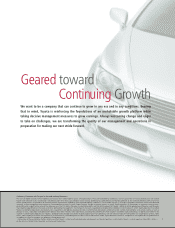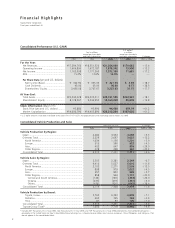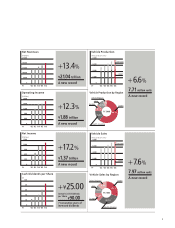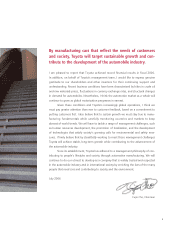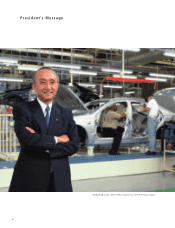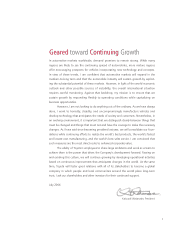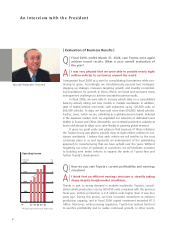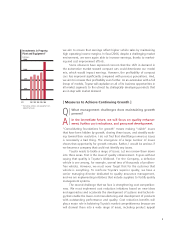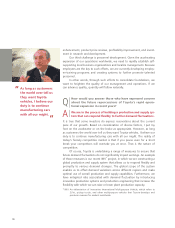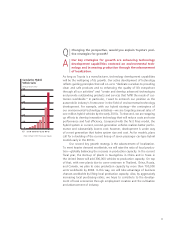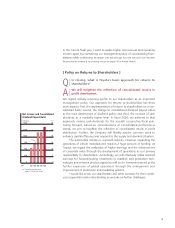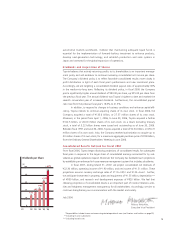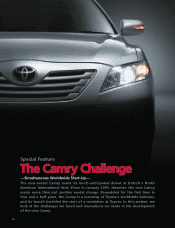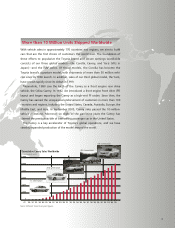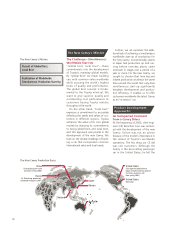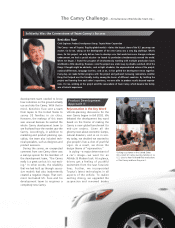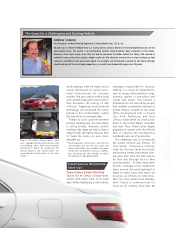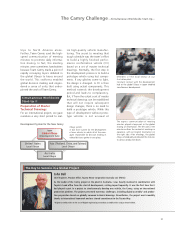Toyota 2006 Annual Report Download - page 13
Download and view the complete annual report
Please find page 13 of the 2006 Toyota annual report below. You can navigate through the pages in the report by either clicking on the pages listed below, or by using the keyword search tool below to find specific information within the annual report.
11
Changing the perspective, would you explain Toyota’s posi-
tive strategies for growth?
Our key strategies for growth are enhancing technology
development capabilities centered on environmental tech-
nology and increasing production through the advancement
of localization.
As long as Toyota is a manufacturer, technology development capabilities
will be the wellspring of its growth. Our active development of technology
reflects guiding principles that call on us to “dedicate ourselves to providing
clean and safe products and to enhancing the quality of life everywhere
through all our activities” and “create and develop advanced technologies
and provide outstanding products and services that fulfill the needs of cus-
tomers worldwide.” In particular, I want to entrench our position as the
automobile industry’s frontrunner in the field of environmental technology
development. For example, with our hybrid strategy—the centerpiece of
our environmental technology initiatives—we are targeting annual sales of
one million hybrid vehicles by the early 2010s. To that end, we are stepping
up efforts to develop innovative technology that will reduce costs and raise
performance and fuel efficiency. Compared with the first Prius model, the
hybrid system in current, second-generation vehicles realizes better perfor-
mance and substantially lowers cost; however, development is under way
of a next generation that halves system size and cost. As for models, plans
call for a doubling of the current lineup of seven passenger-car-type hybrid
models early in the 2010s.
Our second key growth strategy is the advancement of localization.
To meet heavier demand worldwide, we will raise the ratio of local produc-
tion—globally balancing the increase in production capacity. In the current
fiscal year, the start-up of plants in Guangzhou in China and in Texas in
the United States will add 300,000 vehicles to production capacity. On top
of that, with new plants due to come onstream in Thailand, China, Russia,
and Canada, we plan to raise production capacity by more than 700,000
units worldwide by 2008. In this way, we will take advantage of business
chances worldwide by lifting local production capacity. Also, by aggressively
increasing local purchasing ratios, we hope to contribute to the develop-
ment of local economies through employment creation and the cultivation
and advancement of industry.
200
400
300
100
600
500
’97 ’98 ’99 ’00 ’01 ’02 ’03 ’04 ’05
0
Cumulative Hybrid
Vehicle Sales
(Thousands of units)
CY
Note: Different from fiscal year figures
Q
A


